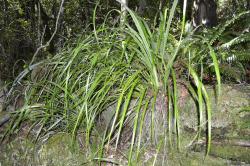- Taxon
- Gallery
- = Astelia cunninghamii Hook.f., Bot. Antarct. Voy. II. (Fl. Nov.-Zel.) Part I, 259 (1853)
- = Astelia cunninghamii subsp. hookeriana Kirk, Trans. New Zealand Inst. 4: 244 (1872)
- ≡ Astelia solandri subsp. hookerana (Kirk) L.B.Moore, New Zealand J. Bot. 4: 230 (1966)
- = Astelia polyneuron Colenso, Trans. & Proc. New Zealand Inst. 14: 333 (1881 [1882])
- = Astelia subrigida Colenso, Trans. & Proc. New Zealand Inst. 19: 268 (1886 [1887]) pro parte
Robust tufted epiphyte, but also growing on ground. Lvs mostly 100–200 × 2–3.5 cm., drooping; just above sheath very narrow, keeled and tightly folded, covered in fine whitish felt; sheath broad, clad on both surfaces in white scales; lamina adaxially bright green, without obvious scales when mature; abaxially silvery with elongate pattern of scales when young, in age minutely dotted with white scale-bases; 3 subequal nerves us. recognizable on each side of midrib, but these well separated, at least in distal half of lf. Infl. drooping, most parts covered with ± appressed scales; peduncles 30–100 cm. × 4–8 mm.; panicle 15–40 cm. long; lower spathes long; racemes ∞, widespreading, more lax in male, all except the smallest spathes subtending sub-infls of 3–(5) racemes. Fls pedicellate and us. well spaced; per. yellowish, pinkish or (especially ♂) maroon, divided almost to base; tepals 2–4–(5) mm. long, spreading, tips lacking scales. Ovary 1-locular, green; style very short. Fr. c. 4–5 mm. diam., globose, translucent green to yellowish or dull brown, seated on dry membr. per. Seeds < 2 mm. long. diam. c. ½ length, terete and ± curved, smooth and shining, the funicular end carunculate. n = 35.
[From: Moore and Edgar (1970) Flora of New Zealand. Volume 2.]
Flowering: Oct.–Jun.; Fruiting: Jan.–Dec.




